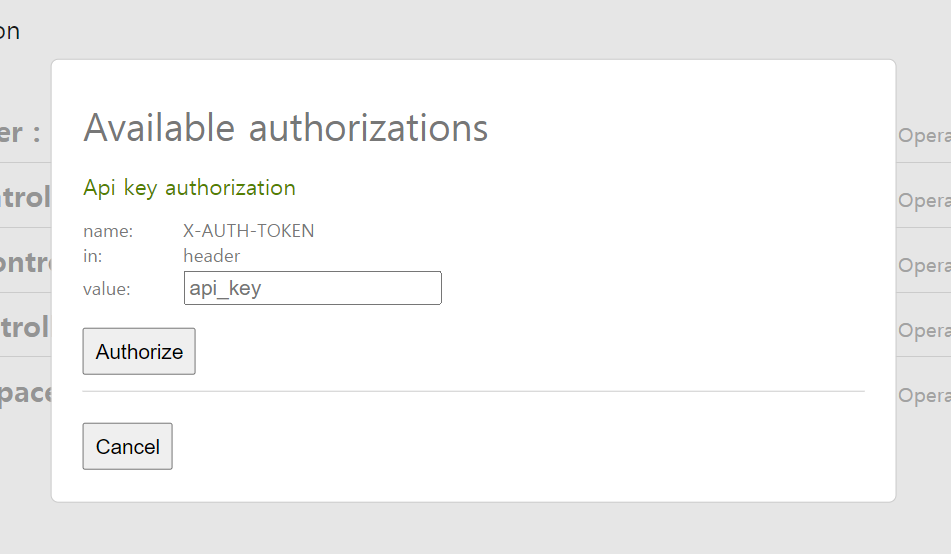✨ Swagger
프로젝트에서 지정한 URL들을 HTML 화면으로 확인할 수 있게 해주는 라이브러리이다.
컨트롤러에 명시된 어노테이션을 해석하여 API 문서를 자동으로 만들어준다.
Swagger는 Java에 한정된 라이브러리는 아니고, node.js, django등에도 지원한다.
세팅을 해보장.
build.gradle
implementation group: 'io.springfox', name: 'springfox-swagger2', version: '2.9.2'
implementation group: 'io.springfox', name: 'springfox-swagger-ui', version: '2.9.2'
// 2.5.0 -> 2.7.0 -> 2.9.2 수정SwaggerConfig.java
@Configuration
@EnableSwagger2 // Swagger2 버전을 활성화하겠다는 어노테이션
public class SwaggerConfig {
@Bean
public Docket api() {
return new Docket(DocumentationType.SWAGGER_2)
.select() // ApiSelectorBuilder 생성
.apis(RequestHandlerSelectors.any()) // api 스펙이 작성되어 있는 패키지 지정 // 현재 RequestMapping으로 할당된 모든 URL 리스트를 추출
.paths(PathSelectors.ant("/**")) // 그중 /** 인 URL들만 필터링
.build();
}
}- Docket : Swagger 설정의 핵심으로 문서화 객체, API에 대한 내용 및 스펙은 컨트롤러에서 작성한다.
http://localhost:8080/swagger-ui.html 로 접속하면, REST API를 볼 수 있다

동아리 면접을 보면서 알게된 툴
나는 항상 REST API 설계 노션에다 쓰고 공유했는데
요런 방법이 있었다니 매우 신기하다
만약 /api 경로 추가해서 /api/**로 설정해야겠다
글고 면접보기 전, 기술 질문을 대비해서 백엔드 면접 공부를 했는데 url에 대문자는 삼가하는 게 좋다고 하더라! loginSuccess 이런 거 다 login-success로 바꿔야겠다
ㅎㅎ
✔ 문서에 대한 정보를 추가해보자
@Bean
public Docket api() {
return new Docket(DocumentationType.SWAGGER_2)
.apiInfo(apiInfo())
.select()
.apis(RequestHandlerSelectors.any())
.paths(PathSelectors.ant("/**"))
.build();
}먼저 api() 메서드에 .apiInfo(apiInfo()) 추가하자
apiInfo() 메서드로 넘어가보자.
private ApiInfo apiInfo() {
String applicationName = "SLACK-CLONE API Documents";
return new ApiInfoBuilder()
.title(applicationName) // 제목 설정
.contact(new Contact("Ayoung Moon", null, "ayong703@gmail.com")) // 연락처 and 이름 설정
.build();
}화면을 보도록 하자.
 요렇게 설명이 나오게 된다 👍
요렇게 설명이 나오게 된다 👍
✔ JWT 인증 기능 추가해보자
JWT를 적용했다면 꼭 이 기능은 있어야 편할 듯하다.
인증이 필요한 메서드마다 유효한 토큰을 넣어야 하고,,,
근데 이 기능 있으면 한 번만 인증하면 편하게 테스트 가능하다!
먼저 springfox-swagger2* version을 2.5.0 -> 2.7.0(->2.9.2)으로 바꿔야 인증 추가가 가능한 것 같다.
(2.5.0으로 계속 헤매다가 2.7.0으로 수정하고 실행하니 바로 됨,, ㅎ)
다시 api() 메서드로 돌아가 코드 추가를 하자.
@Bean
public Docket api() {
return new Docket(DocumentationType.SWAGGER_2)
.apiInfo(apiInfo())
.select()
.apis(RequestHandlerSelectors.any())
.paths(PathSelectors.ant("/**"))
.build()
.securityContexts(Lists.newArrayList(securityContext()))
.securitySchemes(Lists.newArrayList(apiKey()));
}밑에 security* 관련 코드 두 줄이 추가 됐다.
그렇다면 securityContext(), apiKey() 메서드를 살펴보자.
private ApiKey apiKey() {
return new ApiKey("JWT", "X-AUTH-TOKEN", "header");
}
// JWT 인증
private SecurityContext securityContext() {
return SecurityContext.builder().securityReferences(defaultAuth()).build();
}
List<SecurityReference> defaultAuth() {
AuthorizationScope authorizationScope = new AuthorizationScope("global", "accessEverything");
AuthorizationScope[] authorizationScopes = new AuthorizationScope[1];
authorizationScopes[0] = authorizationScope;
return Lists.newArrayList(new SecurityReference("JWT", authorizationScopes));
}apiKey()에서 2번째 파라미터는 헤더에 토큰값을 담을 때 키 이름을 입력하면 된다!!
(나는 X-AUTH-TOKEN으로 설정했다.)
나머지는 요 링크를 참조해서 작성했당.
다시 실행해보면 상단에
 Authorize 버튼이 추가되었다. 클릭해보자
Authorize 버튼이 추가되었다. 클릭해보자 이제 value에 유효한 토큰값만 집어넣으면 인증은 완료됐당. 매우 신기하다 스웩어...... 여태까지 이걸 몰랐다니 놀랍구만.
이제 value에 유효한 토큰값만 집어넣으면 인증은 완료됐당. 매우 신기하다 스웩어...... 여태까지 이걸 몰랐다니 놀랍구만.
✔ Annotation 설명
@Api
해당 클래스가 Swagger 리소스라는 것을 명시
- value : 태그를 작성
- tags : 여러 개의 태그 정의 가능
@ApiOperation
한 개의 operation(API url과 method 선언)
- value : API에 대한 간략한 설명 작성
- notes : 더 자세한 설명 작성
- hidden : method 생략 가능하다(true)
@ApiParam
파라미터에 대한 정보를 명시
- value : 파라미터 정보 작성
- required : true or false
- example : 테스트를 할 때 보여줄 예시
